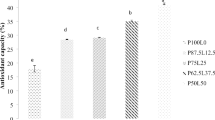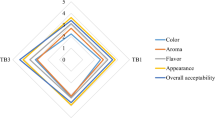Abstract
The aim of this study was to use dried corn silk powder variety of VL Baby corn-1 for formulation of flavoured herbal tea with different combination of Thyme (Trachyspermum ammi), Clove (Syzygium aromaticum), Cinnamon powder (Cinnamomum verum), Timur (Zanthoxylum alatum), Tulsi (Holy basil) (Ocimum tenuiflorum), Gandraini (Achillea millefolium), Lemon grass (Cymbopogon citratus), Blend (Clove + Timur + Gandraini), and one only corn silk without any other herbs and to know antioxidant properties of developed tea. Result of sensory evaluation experiment showed that all combinations were liked moderately. Lemon grass flavour followed by cinnamon and clove blend obtained highest score. Total phenolic content, total flavonoid content, DPPH free radical scavenging activity and total antioxidant activity for all flavour are analyzed and reported. Results on DPPH free radical scavenging activity indicated that corn silk tea had 81.215 ± 0.75 µg/mL whereas blend with Timur had significant highest value and Thyme blend had lowest value 64.20 ± 0.40 among all eight different blends with corn silk. The values for total antioxidant capacity blends with Timur (Zanthoxylum alatu) in corn silk showed significantly (P < 0.05) highest value and Clove, Timur, Gandraini blends got lowest value.

Similar content being viewed by others
References
Zhishen J, Mengcheng T, Jianming W. The determination of flavonoids content in mulberry and their scavenging effects on superoxide radicals. J Food Chem. 1999;64:555–99.
Mckay DL, Blumberg JB. The role of tea in human health: an update. J Am Coll Nutr. 2002;21:1–13.
Abbey L, Timpo GM. Production and utilization of indigenous leafy vegetables: a proposal intervention model for Savannah zones of Ghana. Technical Note, Department of Horticulture, KNUST, Kumasi. Ghana Agric Food Res. 1999;4(4):15–23.
Bender DA. Benders’ dictionary of nutrition and food technology. 7th ed. CRC Press; 2003.
Mithraja MI, Varaprasadham SK, Solomon J. Antibacterial efficacy of Drynaria quercifolia (L.) (Polypodiaceae) against clinically isolated urinary tract pathogens. Asian Pacific J Tropical Biomed. 2012;2:S131–5.
Maksimovic Z, Malencic D, Kovacevic N. Polyphenol contents and antioxidant activity of Maydis stigma extracts. Biores Technol. 2005;96:873–7.
Nurhanan AR, Wan Rosli WI. Evaluation of polyphenol content and antioxidant activities of some selected organic and aqueous extracts of corn silk (Zea Mays Hairs). J Med Bioeng. 2012;1(1):48–51.
Du J, Xu QT. A study on mechanisms of stigma maydis polysaccharide on weight loss in experimental animals. Clin Pharmacol Bullet. 2007;23:816–20.
Zhao W, Yin Y, Yu Z, Liu J, Chen F. Comparison of anti-diabetic effects of polysaccharides from corn silk on normal and hyperglycemia rats. Int J Biol Macromol. 2012;50(4):1133–7.
Rau O, Wurglics M, Dingermann T, Abdel-Tawab M, Schubert-Zsilavecz M. Screening of herbal extracts for activation of the human peroxisome proliferator-activated receptor. Pharmazie. 2006;61:952–6.
Ghorab A, El-Massry K, Shibamoto T. Chemical composition of the volatile extract and antioxidant activities of the volatile and nonvolatile extracts of egyptian corn silk (Zea mays L). J Agric Food Chem. 2007;55:9124–7.
Hasanudin K, Hashim P, Mustafa S. Corn silk (Stigma Maydis) in healthcare: a phytochemical and pharmacological review. Molecules. 2012;17:9697–715.
Bhaigyabati T, Ramya J, Usha K. Effect of methanolic extract of sweet corn silk on experimentally induced hyperthyroidism in Swiss albino rats. Int Res J Pharm. 2012;3:241–5.
Wang CH, Ma YL, Zhu DY, Wang H, Ren YF, Zhang JG, Thakur K, Wei ZJ. Physicochemical and functional properties of dietary fiber from Bamboo Shoots (Phyllostachys praecox). Emirates J Food Agric. 2017;29(7):509–17.
Gwendlin V, Induja A, Manoj J, Shivasamy S. Recent trends in effective utilization of by-product of corn. Indian J Sci. 2015;22:18–26.
Hu QL, Deng ZH. Protective effects of flavonoids from corn silk on oxidative stress induced by exhaustive exercise in mice. African J Biotechnol, 2011; 10(10).
Figueirinha A, Paranhos A, Perez-Alonso JJ, Santos-Buelga C, Batista MA. Cymbopogon citratus leaves: characterization of flavonoids by HPLC–PDA ESI/MS/MS and an approach to their potential as a source of bioactive polyphenols. J Food Chem. 2008;110(3):718–28.
Bhat KS, Vivek K. Biocidal potential of clove oils against Aede albopictus—a comparative study. African J Biotechnol. 2009;8(24):6933–7.
Delaquis PJ, Stanich K, Girard B, Mazza G. Antimicrobial activity of individual and mixed fractions of dill, cilantro, coriander and eucalyptus essential oils. Int J Food Microbiol. 2002;74(1–2):101–9.
Khan A, Safdar M, Khan AMM, Khattak KN, Anderson RA. Cinnamon improves glucose and lipids of people with type 2 diabetes. Diabetes Care. 2013;26(12):215–8.
Kilic C, Can Z, Yilmaz A, Yildiz S, Turna H. Antioxidant properties of some herbal teas (green tea, senna, corn silk, rosemary) brewed at different temperatures. Int J Secondary Metabolite. 2017;43:142–8.
Shi S, Li S, Li W, Xu H. Corn silk tea for hypertension: a systematic review and meta-analysis of randomized controlled trials. Evid-Based Complementary Alternative Med, 2019;1–7.
Amerine MA, Pangborn RM, Roseller EB. Principles of sensory evaluation of foods. New York: Academic Press; 1965. p. 265.
Singleton VL, Orthoffer R, Lameula-Raventos RM. Analysis of total phenol and other oxidation substrates and antioxidants by means of Folin-Ciocalteu reagent. Methods Enzymol. 1999;299:152–78.
Zhishen J, Mengcheng T, Jianming W. The determination of flavonoid contents. Food Chem:Anal, Nutr Clin Methods Section. 1999;64:555–9.
Williams W, Cuvelier ME, Berset C. Use of a free radical method to evaluate antioxidant activity. Lebensm-Wiss.u.-Technol, 1995; 28:25–30 York. Basel. Marcel Dekker. Inc. p.173–190.
Sheoran OP, Pannu RS. Statistical Package for agricultural workers. “O. P. Stat”, 1999; College of Agriculture, Kaul, CCS Haryana Agricultural University, Hisar.
Baratta MT, Dorman H, Deans SG, Fi-gueiredo AC, Barroso JG, Ruberto G. Antimicrobial and antioxidant properties of some commercial essential oils. Flavour Fragr J. 1998;13:235–44.
Kasali AA, Oyedeji AO, Ashilokun AO. Volatile leaf oil constituents of Cym-bopogon citratus (DC) Stapf. Flavour Fragr J. 2001;16:377–8.
Anggraini T. Proses dan Manfaat Teh, Padang: CV. Rumahkayu Pustaka Utama.
Ferry Y. Prospek Pengembangan Kayu Manis (Cinnamomum burmanii L). Diabetes Sci Technol. 2013;4(3):685–93.
Qin B, Panickar KS, Anderson RA. Cinnamon: potential role in the prevention of insulin resistance, metabolic syndrome, and type 2 diabetes. J Diabetes Sci Technol. 2010;4(3):685–93.
Gebrail MW, Zewdu A. Nutritional compositions and antioxidative capacity of red and yellow color of immature and matured corn silks and sensory acceptability of its tea grown in ethiopia. Thesis, M.Sc. Addis Ababa University College of Natural and Computational Sciences Center for Food Science and Nutrition, Addis Ababa, Ethiopia, 2018.
Senphan T, Yakong N, Aurtae K, Songchanthuek S, Choommongkol V, Fuangpaiboon N, Phing PL, Yarnpakdee S. Comparative studies on chemical composition and antioxidant activity of corn silk from two varieties of sweet corn and purple waxy corn as influenced by drying methods. Food Appl Biosci J. 2019;7(3):64–80.
Azli1 SNS, Fadzelly M, Babaji SS, Awang-Kanak F. Nutritional, Phytochemical, Antioxidant Activity and Sensory Attributes of Herbal Infusion from Sukun (Artocarpus altilis) Leaf. AIP Conference Proceedings. Proceedings of the 3rd International Conference on Applied Science and Technology, 2018.
Haslina H, Praseptiangga D, Bintoro VP, Pujiasmanto B. Chemical and phytochemical characteristics of local corn silk powder of three different varieties. Indonesia. Int J Adv Sci Eng Inform Technol. 2017;7(5):1957–2196.
Liu J, Wang C, Wang Z, Zhang C, Lu S, Liu J. The antioxidant and free-radical scavenging activities of extract and fractions from corn silk (Zea mays L.) and related flavone glycosides. Food Chem. 2011;126:261–9.
Sarepoua E, Tangwongchai R, Suriharn B, Lertrat K. Relationships between phytochemicals and antioxidant activity in corn silk. Int Food Res J. 2013;20(5):2073–9.
Das C, Kothari S, Muhuri A, Dutta A, Ghosh P, Chatterjee S. Clove based herbal tea: development, phytochemical analysis and evaluation of antimicrobial property. J Pharmaceut Sci Res. 2019;11(9):3122–9.
Nurhanan AR, Rosli WI. Evaluation of polyphenol content and antioxidant activities of some selected organic and aqueous extracts of cornsilk (Zea Mays Hairs). J Med Bioeng. 2012;1(1):48–51.
Ebrahimzadeh MA, Pourmorad F, Hafezi S. Antioxidant activities of iranian corn silk. Turkey J Biol. 2008;32:43–9.
Zilic S, Jankovic M, Basic Z, Vancetovi J, Maksimovic V. Antioxidant activity, phenolic profile, chlorophyll and mineral matter content of corn silk (Zea mays): comparison with medicinal herbs. J Cereal Sci. 2016;69:363–70.
Acknowledgements
I would like to express my sincere gratitude to GB Pant University of Agriculture & Technology University, Food Science and Nutrition department, chemical testing, laboratory staff for help me during laboratory analysis. The authors acknowledge the NEB CRC (Crop Research Centre) of University for providing samples.
Author information
Authors and Affiliations
Corresponding author
Ethics declarations
Conflict of interest
The authors have no conflict of interest in the different tea described in this paper.
Rights and permissions
About this article
Cite this article
Singh, A., Raghuvanshi, R.S. & Bhatnagar, A. Herbal tea formulation using different flavoured herbs with dried corn silk powder and its sensory and phytochemical analysis. Syst Microbiol and Biomanuf 1, 336–343 (2021). https://doi.org/10.1007/s43393-021-00029-9
Received:
Revised:
Accepted:
Published:
Issue Date:
DOI: https://doi.org/10.1007/s43393-021-00029-9




